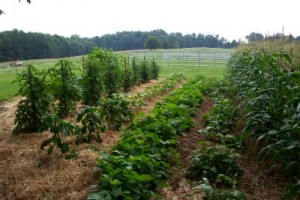| Beans | Cantaloupe | Corn | Cowpeas | Cucumbers | Edamame |
| Eggplant | Garlic | Herbs | Limas | Okra | Peppers |
| Pumpkins | Squash | Sweet Potatoes | Tomatoes | Watermelon |
Summer crops like warm to hot weather. The biggest mistake people make is trying to plant to soon. Even though we have this almost irresistible urge to plant we are not doing our plant friends a favor. The ground needs to be warm at nights 55 degrees and soil temperatures of 65-70 degrees. Old-times would say you need to hear the Whipper-Will calling in the evening. Crops such as tomatoes and peppers will drop their blooms and it can even mess up a peppers ability to produce properly. If the leaves of beans get frost-bitten it can stun them and actually slow down their ability to grown properly.
Frost will kill summer plants. If you do get caught with a late freeze you can cover your plants with newspaper, straw, or plastic. Tomatoes can be covered with 5 gallon buckets or grocery bags but even these will not always protect the tender young plants from the cold. Every gardener learns this hard lesson sooner or later. If frost gets on your plants, you must get up before the sun and sprinkle water on your plants to wash off the frost. If the sun hits the frost, it is too late. The frost is a lethal poison to your plants and they will die.
I like to mulch my summer plants, especially ones that produce all summer or are long growing such as cucumbers, squash, okra, tomatoes, potatoes, peppers, cantaloupe, watermelon or pumpkins. Good mulching reduces a lot of labor by helping to conserve moisture and reducing those hateful, nasty weeds. It also makes the garden pretty and in the fall provides humus to be worked into the soil.
Mulching materials:
- Straw
This is an excellent mulching material but the wheat or barley seeds in the straw will sprout and grow. It is best if the straw is allowed to get wet and go through a heat to kill the seeds before using.
- Newspaper
This is a way to recycle your newspaper! It will blow away if not weighted down. Some like to use it under the straw as an additional weed blocker.
- Grass Clippings
These are free for the getting and a way to dispose of that extra grass. Because it is a green clipping you may have to add extra nitrogen to help compensate for the nitrogen it pulls out of the ground.
- Weed Blocker or Black Plastic
Excellent protection but more expensive and has to be removed in the fall. Always use black plastic as it helps to block the sunlight. Be sure to punch holes in the plastic so water can penetrate.
- Sawdust/Horse Manure
This is my favorite. Since we have a horse stable on the premises, I have ample access to the sawdust/horse manure taken from the stalls during cleaning. I love this as it adds fresh manure at the same time. It makes a mulch that looks good, won’t sprout, grow, or blow away and is free!! But the down-side is, it does smell and will attract flies at first. You also have to be careful when applying that it does not burn your plants. Almost immediately the load of sawdust/manure starts going through a heat for several days and it gets hot to the touch. I have had it actually scald the leaves of my plants, especially crops like cantaloupe that vine on top of the mulch. They grow out of it but it stuns them until they adjust. I try to mulch vines before they start to vine to help eliminate this challenge. When you use a mulch such as sawdust, shavings or grass clippings, nature immediately sends signals to the microorganisms in the soil to start decomposing this foreign product. You also have to compensate by adding extra nitrogen for what gets pulled out of the soil to start decomposing the mulch.
Pat’s 2004 Summer Crop Gardening Calendar
| Description | |
| April 22 | Gene tilled my garden and I am going to let it set to dry a few days before I plant. |
| April 24 | Finally got to plant my garden. This year I did not get a spring garden planted. I really missed the early lettuce, radishes and onions. Today I planted Blue Lake Snaps, onions, Incredible sweet corn, Fordhook Limas, St. Neck Squash, Burpless & National Pickling Cucumbers. |
| April 29 | Planted 8 Whopper Tomatoes, California Wonder Bell Peppers & Clemson Spineless Okra |
| May 15 | Tilled between my rows, hoed and got my garden looking picture perfect! Planted second patch of Incredible sweet corn and Hales Best Cantaloupe. Just as I was finished tilling the tiller lurched ahead on me and I tried to hang on and I reinjured my hamstring. I had pulled it several weeks ago when I slipped and fell on the damp grass playing a game. I thought I was going to faint. Now I am limping around again and can barely walk! |
| May 16 | I want to try a “new” product that we heard about this spring. Corn gluten is a natural, organic pre-emergence weed preventer. We did some research on the internet and discovered a product-that we now carry- called “Concern”. Sprinkled Concern over my garden. It rained tonight so I think I hit it perfect! |
| May 24 | A solid carpet of green grass and weeds has come up in the garden. I have never had so many weeds. I am so disappointed. I believe corn gluten sprouts weeds! |
| May 26 | A friend tilled the garden for me so I would not hurt myself again! Daughter Jill helped me hoe my garden again and got it looking good. It was a big job! What a mess of weeds. Did some reading on Concern and talked to one of my reps. It takes Concern 2-3 weeks to activate. It is suppose to be tilled into the soil and the bacteria will break it down so that it can work. This seems like a real contradiction… if it is a pre-emergence how can you keep weeds from germinating for three weeks? |
| June 10 | I do believe the corn gluten is working. I have some weeds but not near like usual. My corn patch is staying very clean. Mulched the tomatoes, cucumbers, cantaloupe, tomatoes, okra and beans with straw. It looks so clean and fresh and beautiful. |
| June 14 | Had our first mess of yellow squash & fresh cucumbers. Yum! |
| June 21 | Planted edible soybeans. |
| June 23 | Canned 4 quarts of Blue Lake snaps. |
| June 26 | Canned 8 quarts of Blue Lake snaps and brought in first mess of okra. One of my squash plants got zapped with the squash bore. Nasty worm! I had been trying to keep them dusted with Rotenone but we are having so much rain I wasn’t able to keep enough dust on them. Rotenone is organic and does the best job on the bore of any product that I have found. Planted another seed in it’s place. Took pictures of my garden. I am so grateful to God for a wonderful gardening season. |
June 26, 2004 pictures….
Left to right:
Row 1: Whopper tomatoes
Row 2: California Wonder Peppers & Clemson Spineless Okra
Row 3: Blue Lake Snaps
Row 4: Fordhook Limas
Row 5: Incredible Sweet Corn Patch
Blue Lake Bush beans in center with Okra to the right.
I plant my cucumbers on a piece of livestock panel. The Burpless plants look good but the National Pickling plants don’t look as good. They are still producing even though the leaves have yellow spots on them.
Hales Best Cantelope with Incredible Sweet Corn in the background.
Fordhook Limas









